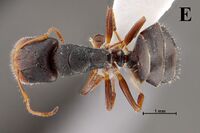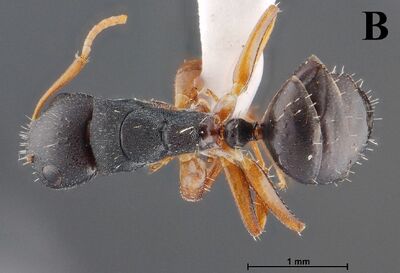Camponotus siamensis
| Camponotus siamensis | |
|---|---|

| |
| Scientific classification | |
| Kingdom: | Animalia |
| Phylum: | Arthropoda |
| Class: | Insecta |
| Order: | Hymenoptera |
| Family: | Formicidae |
| Subfamily: | Formicinae |
| Tribe: | Camponotini |
| Genus: | Camponotus |
| Species: | C. siamensis |
| Binomial name | |
| Camponotus siamensis Jaitrong & Jeenthong, 2022 | |
This species has been known only from the type locality (Mukdahan Province, northeastern Thailand), where a nest was found in a small dead twig in a mixed deciduous forest.
Identification
Camponotus siamensis is similar to Camponotus lasiselene (China and Thailand) (Fig. 2) and Camponotus selene (China, India, and Myanmar) (Fig. 3). However, in the minor worker C. siamensis is clearly distinguished from C. selene by the following characteristics (see figures 2 and 3 for comparison):
- head rectangular, posterior margin weakly concave in C. siamensis (round, posterior margin roundly convex in C. selene)
- propodeum without spines, propodeal junction right angled in C. siamensis (with blunt spines in C. selene)
- dorsal outline of petiole roundly convex in C. siamensis (dorsal outline angulate in C. selene)
- abdominal segments III–VI micorpunctate in C. siamensis (smooth and shiny in C. selene).
Minor worker of C. siamensis can be easily separated from minor worker that of C. lasiselene by:
- posterior margin of head concave medially in C. siamensis (convex in C. lasiselene)
- dorsal outline of petiole roundly convex (dorsal outline angulate in C. lasiselene)
- propodeum without spines in C. siamensis (with spines in C. lasiselene)
- dorsum of mesosoma with less than 30 erect hairs in C. siamensis (over 60 erect hairs in C. lasiselene, see figures 1A and 2A for comparison).
Comparing with major worker, C. siamensis is easily separated from C. lasiselene by:
- head longer than broad in C. siamensis (almost as long as broad in C. lasiselene)
- propodeum without spines in C. siamensis (with short spines in C. lasiselene)
- pilosity sparse (dense but short in C. lasiselene)
- petiole superficially reticulate, with smooth and shining interspaces in C. siamensis (finely punctate in C. lasiselene)
Distribution
Latitudinal Distribution Pattern
Latitudinal Range: 16° to 16°.
| North Temperate |
North Subtropical |
Tropical | South Subtropical |
South Temperate |
- Source: Jaitrong & Jeenthong, 2022
Distribution based on Regional Taxon Lists
Oriental Region: Thailand (type locality).
Distribution based on AntMaps
Distribution based on AntWeb specimens
Check data from AntWeb
Countries Occupied
| Number of countries occupied by this species based on AntWiki Regional Taxon Lists. In general, fewer countries occupied indicates a narrower range, while more countries indicates a more widespread species. |

|
Estimated Abundance
| Relative abundance based on number of AntMaps records per species (this species within the purple bar). Fewer records (to the left) indicates a less abundant/encountered species while more records (to the right) indicates more abundant/encountered species. |

|
Biology
Castes
Nomenclature
The following information is derived from Barry Bolton's Online Catalogue of the Ants of the World.
- siamensis. Camponotus siamensis Jaitrong & Jeenthong, 2022: 34, fig. 1A-F (s.w.) THAILAND.
- Type-material: holotype minor worker, 3 paratype major workers, 9 paratype minor workers.
- Type-locality: holotype Thailand: Mukdahan Prov., Chamcha-I Dist., Cheang Chang Niam Village, 8.vi.2007, WJT07-TH-1075 (W. Jaitrong); paratypes: 3 major workers, 7 minor workers with same data, 2 minor workers with same data but 4.ix.2007.
- Type-depository: TNHM.
- Combination in C. (Orthonotomyrmex): Jaitrong & Jeenthong, 2022: 34.
- Distribution: Thailand.
Unless otherwise noted the text for the remainder of this section is reported from the publication that includes the original description.
Description
Worker
Minor Holotype: HW 1.02; HL 1.06; SL 0.96; EL 0.33; ML 1.32; FeL 1.02; PH 0.33; PL 0.30; CI 97; SI 94; EI 32; FeI 100. Paratypes (n = 7): HW 0.99–1.09; HL 1.02–1.16; SL 0.96–0.99; EL 0.30–0.36; ML 1.29–1.42; FeL 0.99–1.06; PH 0.33–0.36; PL 0.30–0.33; CI 94–97; SI 91–97; EI 30–33; FeI 97–100. Head: In full-face view almost slightly longer than broad (CI 91–97), with weakly convex lateral margin and very shallowly concave posterior margin. Mandibles subtriangular; masticatory margin with 5 teeth, including large apical tooth. Clypeus slightly shorter than broad; anterior and posterior margins weakly concave. Eye weakly convex and located at 2/3 distance of head (measured from anterior margin of clypeus to posterior margin of head); distance between mandibular insertion and anterior margin of eye 1.67 times (in holotype) as long as maximal diameter of eye; outer margin of eye reaching lateral margin of head. Antennal scape almost as long as head length, when laid backward extending beyond posterior margin of head by its 1/3 length; segment II longer than each of segments III–VI. Frontal lobe narrow, in full-face view not covering antennal socket. Frontal carina narrow, short, and extending little beyond anterior margin of eye. Mesosoma: in profile view promesonotum with weakly convex dorsal outline; promesonotal suture present; metanotal groove deep clearly separating mesonotum and propodeum; propodeum relatively short, its dorsal outline almost straight; propodeal junction almost right angled; mesopleuron clearly demarcated from pronotum by deep suture but not clearly separated from metapleuron; metapleuron demarcated from propodeum by indistinct groove; in dorsal view, pronotum subrectangular, shorter than broad, its anterolateral corner produced as triangle; mesonotum round, as long as broad, and narrower than pronotum but broader than propodeum; dorsum of mesosoma laterally marginate along lengths of pronotum and propodeum. Metasoma: petiole in profile view, almost as long as heigh, dorsal outline convex. Abdominal segment III (= first gastral segment) as long as each of segments IV and V.
Dorsum of head entirely macropunctate, while ventral face with weaker punctures; mesosoma finely punctate; petiole reticulate with shining interspaces; abdominal segments III–V finely micropunctate. Leg micropunctate but shiny.
Pilosity comparatively sparse and short; petiole with 3–4 erect hairs on each lateral side. All erect hairs white. Entire body black to dark brown, gaster (abdominal segments III–VII) slightly paler. Legs and antennae yellowish brown.
Major Paratypes (n = 3): HW 1.35–1.42; HL 1.65–1.78; SL 0.99–1.06; EL 0.43; ML 1.72–1.75; FeL 1.12–1.16; PH 0.50–0.53; PL 0.36; CI 80–82; SI 71–76; EI 30–32; FeI 79–85.
Head: In full-face view clearly longer than broad (CI 80–82), sub-rectangular with lateral margin feebly concave medially and posterior margin concave; posterolateral corners of head convex. Mandibles subtriangular; masticatory margin with 5 large teeth, including large apical tooth. Clypeus sub-rectangular, slightly longer than broad; lateral and posterior margins of clypeus straight, but anterior margin convex. Eyes elliptical and located just posterior to mid-length of head; distance between mandibular insertion and anterior margin of eye 2.43–2.50 times as long as maximal diameter of eye; in full-face view, outer margin of eye not reaching lateral margin of head. Antennal socket located at mid-length of head. Antennal scape clavate, much shorter than head length, when
laid backward not reaching posterior margin of head; antennal scape 0.73–0.75 times as long as head width. Frontal lobe narrow, flat, in full-face view not covering antennal socket. Frontal carina sharp and reaching level of posterior margin of eye. Mesosoma: slightly smaller than head; in profile view promesonotum with weakly convex dorsal outline; promesonotal suture present; metanotal groove deep clearly separating mesonotum and propodeum; propodeum relatively short and its dorsal outline weakly convex; propodeal junction obtusely angulate; mesopleuron clearly demarcated from pronotum by deep suture, and demarcated from pronotum by indistinct suture but not clearly separated from metapleuron; metapleuron demarcated from propodeum by indistinct groove; in dorsal view, pronotum subrectangular, shorter than broad, its anterior margin convex and posterior margin concave; mesonotum almost as long as broad, and narrower than pronotum but slightly broader than propodeum. Metasoma: petiole in profile view, sessile, almost as long as high, with convex dorsal outline. Abdominal segment III (= first gastral segment) as long as each of segments IV and V. Anterior half of head dorsum punctoreticulate, while posterior half finely macropunctate; mesosoma macropunctate but punctation weaker than in minor worker; petiole superficially reticulate, with smooth and shining interspaces; abdominal segments III–V finely micropunctate. Leg micropunctate but shiny.
Pilosity comparatively sparse and short; petiole with 4 erect hairs on each lateral side. All erect hairs white.
Anterior half of head and antenna yellowish brown, remaining body black to dark brown, gaster (abdominal segments III–VII) slightly paler. Legs reddish brown.
Type Material
- Holotype (THNHM-I-24794, THNHM), minor worker, NE Thailand, Mukdahan Province, Chamcha-I District, Cheang Chang Niam Village, mixed deciduous forest (MDF), 8.VI.2007, W. Jaitrong leg., WJT07-TH-1075.
- Paratypes. Seven minor workers (THNHM-I-24795 to THNHM-I-24801, THNHM) and 3 major workers (THNHM-I-24802 to THNHM-I-24804, THNHM), same data as holotype; 2 minor workers (THNHM-I-24805 to THNHM-I-24806, THNHM), NE Thailand, Mukdahan Province, Chamcha-I District, Kheang [Cheang] Chang Niam Village, dry evergreen forest (DEF), 4.IX.2007, W. Jaitrong leg.
Etymology
The specific name is an adjective meaning ‘of Siam (old name of Thailand)’.



